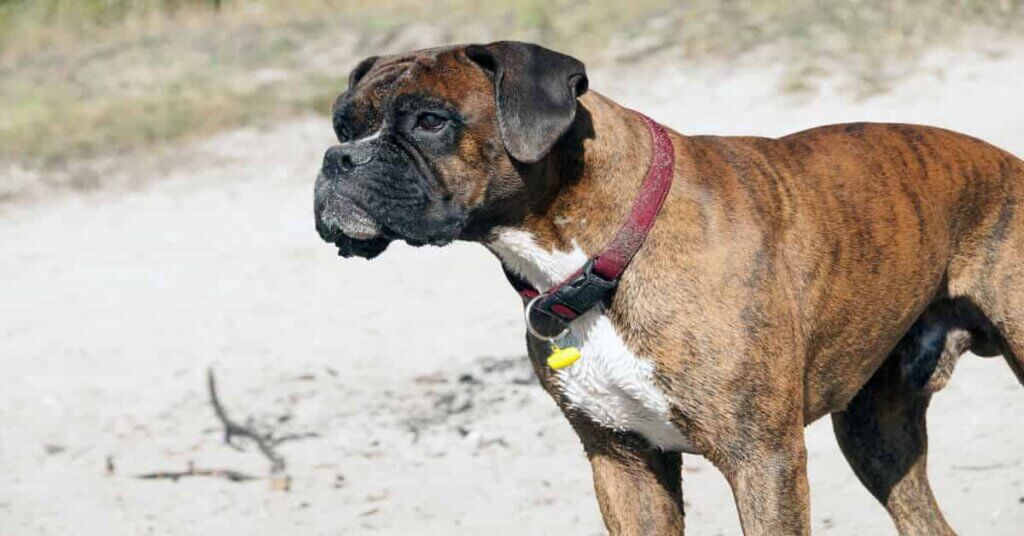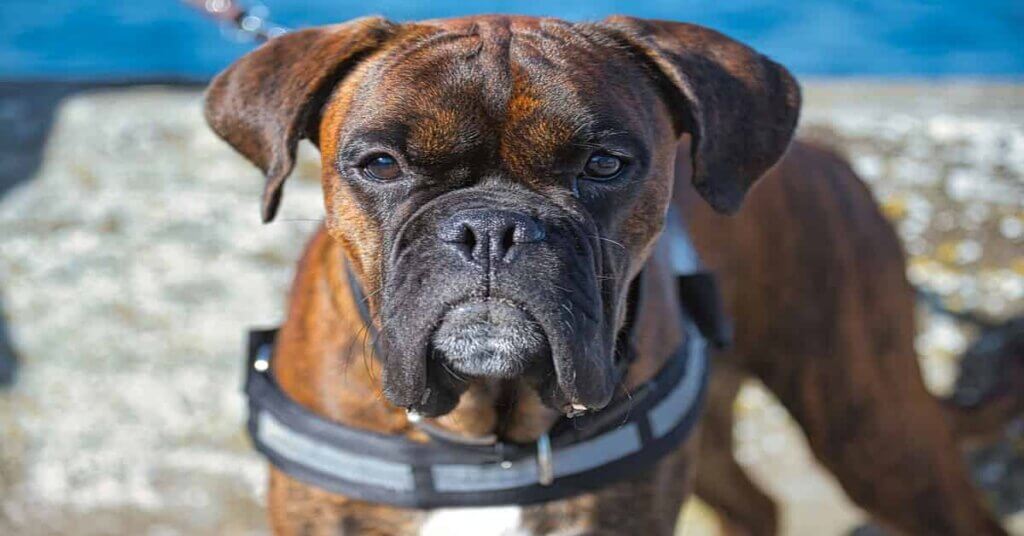Embark on a journey to discover the fascinating world of the Boxer dog breed, known for its distinctive blend of strength, intelligence, and grace. This medium to large-sized breed, originating from Germany, exudes a unique combination of robustness and affection, making them beloved family companions. With their smooth coats, ranging in colors from fawn to brindle, and their bright, alert expressions, Boxers are a sight to behold.
Our in-depth exploration will cover everything from the essential Boxer dog training tips to understanding their health care, best diet, and grooming needs. We’ll delve into the nuances of their temperament and behavior, offering insights into how to raise a happy, well-adjusted Boxer. Join us as we uncover the joys and challenges of living with these energetic and loyal dogs, ensuring a fulfilling life for both you and your Boxer companion.

Table Of Content
Characteristics of a Boxer Dog
The Boxer dog, a breed that exemplifies a blend of athleticism and charm, possesses a set of characteristics that make it uniquely appealing. Originating from Germany, Boxers are medium to large-sized dogs known for their muscular build and agility, a trait that underscores their history in hunting and as working dogs.
Their smooth, tight-fitting coat, which comes in fawn, brindle, or white, adds to their striking appearance. Key to Boxer dog training tips is understanding their energy and intelligence. These dogs are eager to learn and respond well to positive, consistent training methods, making canine training methods an essential part of their upbringing.
They also make good guard dogs due to their distrusting behavior towards strangers. Boxers are often used as police dogs due to this reason. They are also sometimes sent on military missions for this same reason.
Boxers are also good with children and other pets. They require attention and companionship, which is why a family is often the perfect fit for them. The boxer has recently become one of the most popular breeds to be adopted.

The Boxer breed was originally developed in Germany during the nineteenth century. It was initially bred as bull-baiting dogs. They were used in a sport called “Bull Baiting,” where these dogs would wear the bull out till it collapsed.
Origin of the Boxer Dog Breed
This was a source of entertainment for the common people back then. Later on, these Boxers were bred as helpers for butchers. The boxers helped keep the cattle in check in the slaughterhouses. This is where the name Boxer is thought to have come from by many historians. They believe the name Boxer came from the German word “Boxl”. A contradictory belief also exists.
Some people believe that the name Boxer came from the fact that these dogs use their forepaws to play, hence imitating human boxers. The boxer breed is said to be a mix of the Bullenbaiser (the Mastiff), the Bulldog, the Great Dane, and possibly the Terrier breed.
The Bullenbaiser breed is now extinct, however. The Boxer breed was brought into The United States after World War 1. Following this, it became one of the most popular breeds in the United States of America.
The Boxer breed was the first dog breed to be considered a police dog. Due to their tenacity and working history, they became the first police dogs ever. In modern times, they are also bred as companion dogs for individuals and families.

Boxers are a medium to large dog breed that are commonly sized at a height of 22 to 24 inches, and a weight of 50 to 80 pounds.
Physical Attributes of a Boxer Dog
Male boxers usually measure at a height of 24 inches, while female boxers measure at a height of 22 inches. Male boxers usually weigh between 65 to 80 pounds, while female boxers usually weigh between 50 to 65 pounds.
Boxers have a square-shaped head which is pretty unique from other dog breeds. They usually have wide and flattened faces which are complemented by droopy eyes and floppy ears. Their muzzles are unsharpened and their jaws are undershot. Boxers usually have short and sturdy backs as they were initially bred for bull-baiting.
Their tails are usually removed partially or fully which is why they typically stand erect. They have compact and webbed feet. They have a short coating that is characteristically flat. It sheds in moderate amounts. Their coating comes in the colors of Fawn and Brindle.
Their skin might also have white flashings, but it’s not found in all boxers. The white markings can be found on their chest and paws, or sometimes on their faces. They usually also have black masks, though it is not necessarily found in all boxers.
Boxers are very high on energy since they are a working dog breed. They have a low tendency to bark and a moderate tendency to snore, which makes them ideal house pets for many families. Their tendency to dig is also low. Their drooling levels are high, however. They usually live for around 8 to 10 years.
The personality of a Boxer Dog
Boxers are highly energetic dogs due to them being bred for bull-baiting purposes. They are also very playful and fun-loving. They like to stay occupied and entertained. This is why they usually both demand and require a lot of attention.
They are also an intelligent breed, which is why they became the first-ever breed to become police dogs. Moreover, they are good guard dogs since they have an acute sense of hearing. They are very suspicious of strangers and do not befriend them easily.
However, they are not usually aggressive unless they detect a threat. They are tenacious as well as loyal, both of which make them good protectors.
Boxers are really good with children and other pets. This makes them an easy addition to families. Their playfulness and high energy levels are compatible with children. They are also very patient around children.
Taking Care of a Boxer Dog

Like with any other pet, it is important to nurture your boxer properly. A proper upbringing is likely to result in a healthier relationship between your boxer and you. It is likely to make them more suitable for the desired environment.
To begin with, since boxers are a very energetic breed, it is important for them to exercise daily. Since they are very playful, playing can be a medium of exercise. Play with them every day. Another more common mode of exercise is taking them on walks daily.
Since they have high exercise needs, take them on a walk twice a day for at least half an hour. Moreover, ensure that your Boxer receives a balanced diet. It will help them stay fit and active. Since boxers have short coatings, they are typically intolerant of very hot or cold weather. They need protection during such harsh weather.
Grooming Tips for your Boxer Dog
The boxer breed sheds a moderate amount, so their grooming requirements aren’t very taxing. They should be brushed weekly with a bristle brush or a grooming mitt. The grooming mitt should be rubber to ensure it is not too rough on your boxer’s skin.
The Boxer breed does not have a specific requirement for bathing. So, bathe your boxer according to need. A preferred routine could be giving them a bath once every three weeks. Bathing them too often could result in a dry coat. Moreover, make sure to use dog-friendly shampoo.
Your boxer’s teeth should be brushed numerous times a week. Brushing their teeth every day would be ideal. This will improve their dental health by removing bacteria and tartar from their teeth.
You should also trim their nails once or twice a month. This is both good for you and your dog. You can avoid unpleasant and painful encounters with your boxer by keeping their nails trimmed.
Paw wax should be applied 2 to 3 times a week to keep their paws from getting too dry and cracking up.
During grooming, remember to examine your boxer for sore spots, rashes, redness, inflammation, and tenderness. These could be signs of illness or infections. Check for these in their ears, nose, mouth, and eyes as well. If you spot any of the aforementioned signs, it is advisable to take your dog to the vet and get them checked up.
In summer, don’t take your boxer out for a walk in the scorching sun since they are sensitive to extreme heat. In the winter, cover your boxer up with a vest or raincoats to
keep them safe from the extreme cold.
How To Train Your Boxer Dog?

A boxer’s training, like any other dog, should be started from when they are a puppy. This allows them to grow into the habits that you want to teach them.
Training a pet is never an easy task. Firstly, you need to prepare yourself. You have to be patient and dominant throughout the whole process. You have to be the alpha and keep your dog in command during the whole training process.
It is easier to teach and nurture puppies than adult dogs. To start their training, you first have to know about their personality. Then you have to cater the training to their unique personality. Usually, a rewards system is the most commonly used training method as this is easy and yields good results.
Here, rewards are given whenever the dog performs the desired action on command. It teaches them which acts are appreciated and which are not. Socialization is an important part of their training. Make sure you socialize with your boxer enough.
Boxers require a lot of attention and do not like being left alone. If sufficiently socialized with, they will grow up to be more responsible and loyal. It will also help prevent aggressive behaviors such as biting problems, excessive barking, or chasing in the future. While training your dog, ensure that they receive sufficient exercise. This will allow them to become more active.
If you face difficulty while training your boxer puppy, it is suggested to go to the vet for advice.
How To Feed A Boxer Dog?
Feeding is an important aspect of taking care of any pet. When deciding on what to feed your boxer, you should first find out their basic requirements. It is necessary for them to have a balanced diet that is tailored to their needs. This will stimulate healthy growth.
Boxer puppies aged between 8 to 12 weeks should be fed four meals per day to strengthen their bodies and help them grow. Boxer puppies, aged between 3 to 6 months, require to be fed 3 meals a day. They are still in their growth period, so 3 meals are advisable. Boxer puppies, aged between 6 months to 1 year, should be fed 2 meals a day.
Boxers that are aged more than one year require one meal per day. However, they can be given two meals a day. You should feed your boxer on a regular schedule. Your boxer should also be given plenty of water to drink.
It is also suggested to give your dogs treats or snacks throughout the day. Acts as a reinforcement as well as keeps them satisfied. It has to be ensured, however, that the treats or snacks do not make up more than 10 percent of their total food intake.
Some things should be avoided when buying dog food. Make sure the recipe does not contain the following: alcohol, citrus fruits, chocolates, raisins, grains, garlic, onions, yeast, chives, or added preservatives. They can potentially be harmful to your boxer. Buy recipes with real meat as its base to ensure your dog receives a protein-packed meal to support its growth.
Here are some brand suggestions for your boxer:
Royal Canin Boxer Puppy Food/ Royal Canin Boxer Adult Dog Food
Whole Earth Farms Natural Formula
Blue Buffalo Wilderness
ACANA Heritage Dry Dog Food
Orijen Senior Formula
Health Risks of a Boxer Dog
Cancer
Boxers are more susceptible to cancer than other dog breeds. They are prone to developing brain tumors. Boxers with excessive white markings are also prone to skin cancer.
Boxer Cardiomyopathy
This is a heart condition that is often found in the boxer breed. This disease stops your boxer’s heart from pumping blood properly to the rest of the body.
Bloat
Bloating is a serious condition when dogs are in question. This causes your boxer’s gastrointestinal system to swell and prevents your dog from digesting food. It is usually a result of overeating. This is why a boxer’s diet has to be carefully monitored.
Hip Dysplasia
Hip Dysplasia is when your boxer’s hip joints do not form properly. This leads to arthritis. This immense discomfort can be treated, so it is important to identify it fast. Since boxers are an athletic breed, hip dysplasia can be pretty difficult for them both physically and mentally.
Seizures
The boxer breed usually suffers from Grand Mal Seizures. This is caused by epilepsy. The cause of this epilepsy is usually unknown. However, they are still treatable.
Hypothyroidism
In this condition, your boxer fails to produce sufficient thyroid hormones. It can be treated with pills after diagnosis. However, the treatment will continue for their whole life.
To Know more about Boxer Keep your eyes on Boxers Category Page.
Training and Exercise of a Boxer Dog
Boxers, with their boundless energy and keen intelligence, require a focused approach to training and exercise. Adhering to Boxer dog training tips, which emphasize patience and positive reinforcement, is key in shaping their obedient and sociable nature. Canine training methods for Boxers should include a mix of obedience training, agility exercises, and mental stimulation to keep them engaged. Given their high energy, an exercise regimen for Boxers is essential, involving daily walks, playtime, and interactive games. Such routines not only cater to their physical health but also aid in managing the Boxer dog temperament and behavior, preventing boredom and destructive tendencies.
Health care for Boxers also intertwines with their exercise needs. Regular physical activity helps in preventing common illnesses in Boxers, like obesity and joint issues. For Boxer puppy care, a guide that balances gentle training with adequate playtime is crucial for their development stages. Remember, consistency and understanding of their unique needs will ensure that training and exercise for your Boxer are both enjoyable and effective, fostering a strong bond between you and your pet.
Nutrition and Diet of a Boxer Dog
The nutrition and diet of a Boxer dog play a crucial role in their overall health and well-being. Boxers require a diet rich in high-quality proteins to support their muscular physique, aligning with the best diet for the Boxer breed. It’s essential to incorporate dog nutrition that includes a balance of proteins, fats, carbohydrates, and essential vitamins and minerals. This breed’s dietary needs can vary, so understanding the specific nutritional requirements and adopting a dog breed health-focused approach is vital. For instance, puppy development stages require diets that support growth, while senior Boxer food options should cater to their changing metabolism.
Healthy weight management is a key aspect of Boxer care, as they can be prone to obesity. Therefore, meals should be portioned correctly, and exercise routines should complement their diet. Regular vet consultations can provide guidance on the ideal diet, whether it’s commercial dog food or homemade meals, ensuring your Boxer maintains optimal health. Furthermore, Boxer-specific dog food formulas may offer tailored nutrition, especially for those with sensitivities or specific health concerns.
Temperament and Behavior of a Boxer Dog
The temperament and behavior of the Boxer dog are marked by a unique combination of vigor, intelligence, and affection. Known for their loyalty and protective nature, Boxers are excellent family pets, displaying a deep bond with their owners. Their playful and energetic demeanor requires regular engagement through exercise and mental stimulation. Boxer dog training tips often stress the importance of early socialization and consistent training to harness their natural exuberance positively.
Boxers thrive on interaction and are known for their patient and gentle attitude towards children. Understanding and channeling the Boxer dog temperament and behavior through appropriate training and exercise can lead to a well-adjusted and happy canine companion, reflecting the true essence of this charismatic breed.
Lifespan and Aging of a Boxer Dog
The lifespan of a Boxer dog typically ranges between 10 to 12 years, and understanding the aging process is crucial for providing appropriate care. As Boxers age, their dietary needs may change, necessitating adjustments to ensure they receive the best diet for their breed. It’s vital to be vigilant about health care for Boxers, especially as they become more susceptible to age-related conditions.
Common illnesses in Boxers, such as heart problems or joint issues, require early detection and management. Providing a comfortable living environment, coupled with regular veterinary check-ups, can help maintain their quality of life in their senior years. Additionally, adopting a gentler exercise regimen for Boxers as they age is important, balancing their need for activity with their decreasing energy levels.
Conclusion
Embracing the journey with a Boxer dog means understanding and catering to their unique needs throughout their life. From providing effective training and adequate exercise to ensuring proper nutrition and healthcare, each aspect plays a vital role in their well-being. Recognizing the changes as they age and adapting your care accordingly is crucial for their comfort and happiness. Boxers, with their loyal and affectionate nature, offer a rich and rewarding companionship. By committing to their health, training, and overall care, you ensure a fulfilling life for both you and your beloved Boxer.




